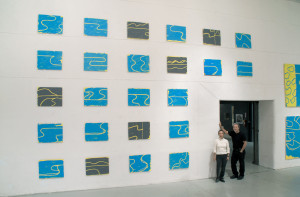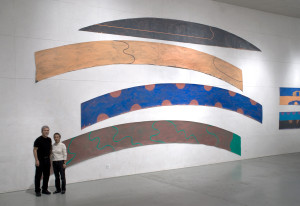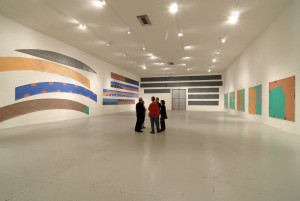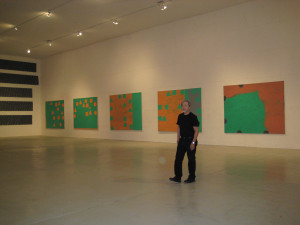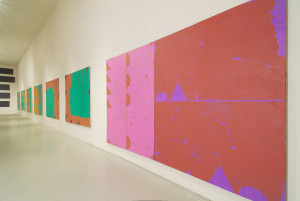Hitoshi Nakazato: Painting Series
With a tribute exhibit by his friends and colleagues
Oct. 4 – 10, 2007
“ Hitoshi as an artist is a transcendentalist. He is also a subtle, untiring and true deconstructionist of convention, and a paradox on top of it all. I have previously described his work as that of a minimalist that has little to do with minimalism, a formalist who makes no formal decisions, a sensual colorist who deploys an abstract and distant conceptual color structure…an off-hand constructor of works that are pregnant with anti -expression, full of innocence by way of negation.…”
Daniel Dalseth, MFA 2002
The Bigger Picture
I knew that Hitoshi Nakazato was a remarkable artist and thinker from my first moments as his student. Watching and listening to his demonstration on making monotypes I was captivated by the efficiency of movements and the unhesitating manner in which he interacted with the materials. When I listened closer to his commentaries, they were littered with such anecdotes that only a serious intellectual and a participant in the history of art could relay. During studio visits Hitoshi continually astonished me with the way he said things by talking about something else. He was always pointing to the larger issues, a path onward. He was and still is a model to me of the artist as inquisitor, seeker, and doer.
Hitoshi as an artist is a transcendentalist. He is also a subtle, untiring and true deconstructionist of convention, and a paradox on top of it all. I have previously described his work as that of a minimalist that has little to do with minimalism, a formalist who makes no formal decisions, a sensual colorist who deploys an abstract and distant conceptual color structure…an off-hand constructor of works that are pregnant with anti -expression, full of innocence by way of negation.
In his life, he has straddled worlds and carried his experiences into the studio, forging them into the terms of his pictorial language, stripping away the thoughts and focusing on the delicate issue of being, moment to moment. Growing up in the aftermath of the atomic bombing of his country, coming of artistic and intellectual age in the 60’s ferment which saw him as a student at the University of Pennsylvania in the company of Barnett Newman, Helen Frankenthaler, Robert Motherwell, Clifford Still, Robert Morris and others, being denounced upon returning to Japan by the student body – including a public interrogation and forced confession to being a capitalist sympathizer…being discharged from his university position for suspicion of being a student sympathizer, and then going into what may be seen as a voluntary exile, never to permanently return to his homeland. These are some of the definitive experiences which shape his outlook.
Talking with Hitoshi, you realize that his work is an internalization and compression of a struggle, a human’s struggle to exist or a civilization’s struggle to survive in spite of itself. The struggle to make a valid image is parallel to his struggle to maintain a position of mental clarity when assessing the condition of the world around himself. His practice is intimately linked with this thought that the achievement of new frontiers in image making is akin to the actualization of steps towards personal enlightenment. In light of these two separate aspects of his work, it is interesting to consider its graceful nature. They appear simple and rather effortless, abstract and detached. But Hitoshi’s works are precisely of that type in which so much is hidden, including an utter mastery of the medium of painting.
To fully understand what motivates Hitoshi in his relentless activity, you have to go back to the beginning of his life. During an interview in 2005, which I conducted on the occasion of his solo exhibition at Pageant : Soloveev, we did just that. I was struck by the extent to which he discussed the prevalent political and social conditions which surrounded the pivotal times of his artistic career. Obviously this was not a person blissfully ensconced in a studio, absorbed in esoteric pursuit of painting Nirvana. What follows is excerpted from this conversation. May Hitoshi continue to create his artistic legacy, and on behalf of all those whom he has inspired throughout the years, I thank him for all that he has given to the world.
DD: You talked about how difficult conditions were in Japan in your youth, somehow you ended up in art school…yet you seem very sensitive to social conditions in a way. You talk about experiencing certain events and how that made you feel that there wasn’t a reason or place to make art, but from the beginning you were working in art with the aftermath of the destruction of your country around you…
HN: I don’t want to be nostalgic…But I think [I have] a hungry spirit…hunger…I went to school with bare feet, you know winter too, no glass in the window, it was all broken , no stove…it was a very difficult time…The post war struggle, starvation, literal starvation, but mentally I was hungry…. I went to school, a Christian school…In 1948 I entered that school as a 7th grader, the head of the school talked about the history of his alma mater Oberlin and what it had accomplished. It was [the] 1st racially integrated school, first co-ed school, and so on, [demonstrating] how American society was organized, functions, democracy [and] what it was all about … we were brainwashed (laughter) so that hunger and [thus] to come to the United States became a big thing… it was a dream to come to the States…I wasn’t supposed to spend my whole life here though, you know I was going back to Japan. So after Penn and 2 years in New York I went back and started to teach in at my alma mater [Tama Art University]. The student [uprising lasted] two years I was there, and I was discharged [from my position]….In the end of the 60s in the environment I was living in Japan, the interrogation I had to go through with the students, it was so much an anti-establishment movement and the movement against….everything coincided: myself, society, international relationships, the painting. The practice of painting was totally …invalid for me. Any kind of brushstrokes, the cycle of tube to palette to canvas…Buying a tube from the art store didn’t make sense… I thought the most valid image making area is the blackboard in the classroom, [where] the image appears and disappears…
A basic thought is anything that come out from me is mine, therefore the issue should be how many things I can do, rather than seeking [a] coherent style. It should emerge or it should prevail on its own. So my issue in the studio is to do something always different. More different is better and if its so different that I can’t accept it, maybe I have to retrain myself or my mind or sensitivity has to be changed. So I try not to look at them [the works]. Just do it and just put it away…. you know its like a diary in a way, you remember that moment,
DD: And the paintings are all dated..
HN: Yeah, date[s]. I’m missing some numbers. I mean dates around 9/11. I thought I kept painting. I thought about a month is absent, missing somewhere. I cannot find it [in] the painting of that era, that about a month span…I felt so impotent in society. I didn’t know what to do. Is it ok to stay in the studio and keep painting? What is going on , whatever is going on in the society, and being in the studio it was so invalid it felt. I wrote sometime ago that I solved that issue though, that artists are involved in imaginations. Imagination is the prime motivation of human existence.
Fine art history is a history of [artists] losing functions in society…losing social functions…you know artists served the power, the rich…to the commoners, then we served ourselves. But technology now [provides people] with self expression people are serving themselves….I felt that the last function of artist [as] commodity maker[was] to entertain…the rich, you know that [it was]one of the things I wanted to… at this point I don’t really care that much. Its a commodity, fine but somehow…the numbers of work I do somehow the more I do…it could be a possibility of something [to] come out more, I’m not saying that clearly but …in Buddhist terms its a one chant sect or a sect chanting many [different chants]…the salvation, which is more better salvation ? …so I think I took numbers and trying to stumble into, will hit something this way to go beyond this known world. Or go outside, this outside of experience world.
The “line outside” series [came] from Sengai [Monk on a Cliff]…the Japanese Zen priest of 18th century reached [out to use an] image of the three primary shapes, hundred years before the Russian suprematists reached [it] and something like that…how do you get there? And Sen-gai means also “line outside” [the] known world, the known world encircled by this line, so going beyond that line. Line outside. Drawing. To draw a line to go beyond the boundary, how do you go beyond that? Thats one thought. I’ve been using that title so much that I got bored [laughs] so I got a new one, its called… Monado…Monado is an elementology, come from a Greek philosopher to [17th century mathematician & philosopher] Leibnitz…The elements create, combination of elements create the world. All the philosophers lived and tried to explain the structure of the Universe with those elements…and I’m using those primary elements to describe my small universe that’s a painting. Painting’s a universe of its own so I changed the name of the painting.
DD: A couple words from you about how you see yourself,…
HN: Well, I ‘m a Japanese artist from a particular period. I just can’t wipe out all my background. but I left Japan in the 1970s. So I go back twice a year or three times a year. But still [my] main life experiences [took place] by the 70’s. So when I say Japanese background, ‘40s ‘50s…early ‘60s and ‘70s.Today there is lots of focus on Japanese sub-culture…animation and so on. I’m quite far away from it. If you are living in Japan, if I [were to] live in Japan, a Japanese artist is not really concerned with Japanese identity because everyone is the same. So the issue is brought up when I come here. There is a political issue—political not government politics, but political in terms of a lifestyle, the choice of material, the choice of image. Whatever I do I create the image. You notice though that I use the primary shapes but I never paint the primary shapes alone. There’s one circle here…but I never painted circl…I painted the background. As a result , the circle came out. I always painted the air. I painted air: between the space, between the shapes, the space came out, between the lines, I painted, filled in. I never painted [an] object or certain image. I painted the air, the background. And since I placed the paper cut out and painted on top of it, I lift up the paper, there’s a square, triangle, and a circle. Because I didn’t want…my activity of brushstrokes [to be] contour lines. I’m not interested in painting [a] circle, triangle, or any other shapes, so I painted background. No image. Well we have a body language. You do something, it tells you—we communicate by body language. [It is] the same way in painting. I don’t need to paint image[s] to relay my thought, I just paint. I think that’s very much like a political statement.
Daniel Dalseth, Pageant : Soloveev Gallery, director, owner
2007 Ice Box, Philadelphia July 16th, 2015admin

